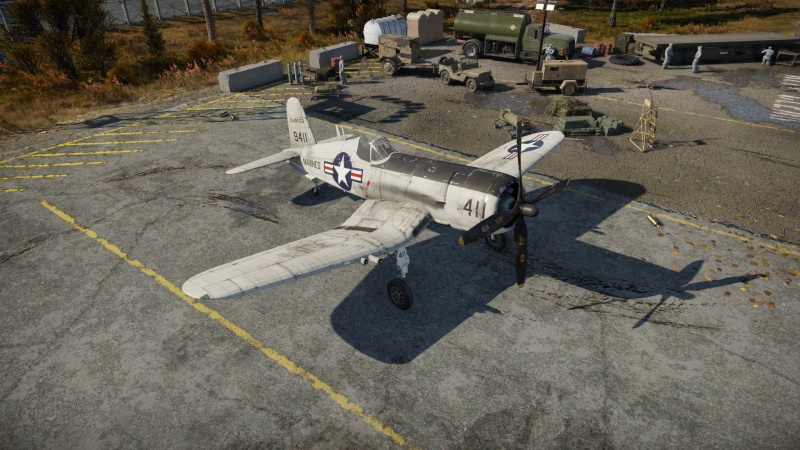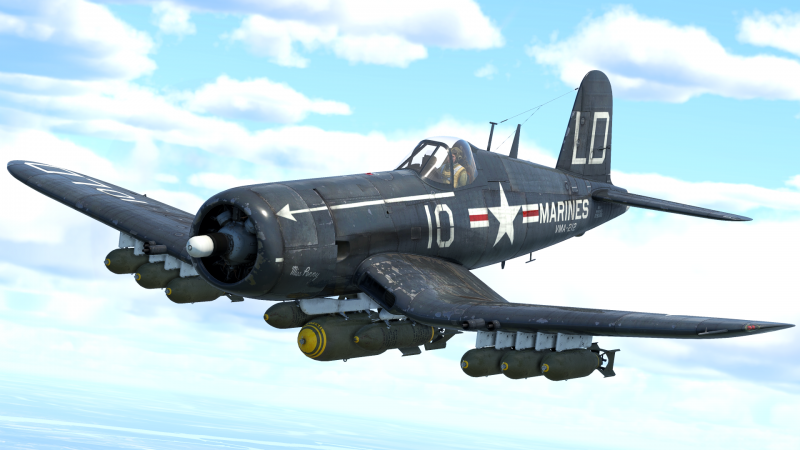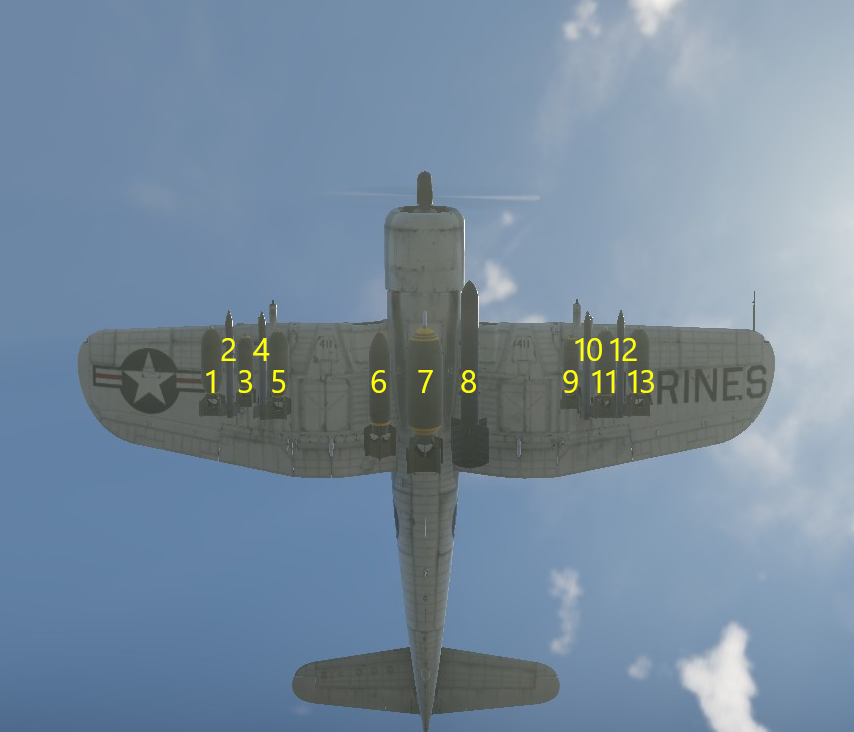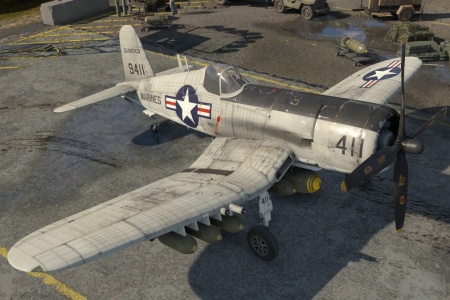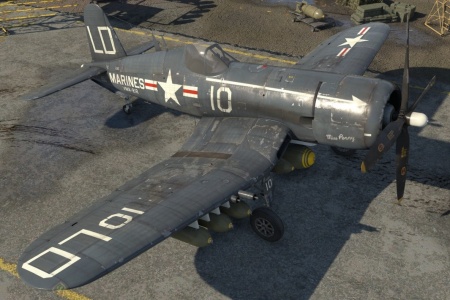AU-1
Contents
Description
The AU-1 Corsair is a premium gift rank IV American strike aircraft with a battle rating of 5.7 (AB/RB/SB). It was introduced during Update 1.97 "Viking Fury" as a reward for the 2020 "Space Race" event.
The AU-1 was a variant of the F4U Corsair developed from the F4U-5, and was originally designated as the F4U-6 but was renamed to AU-1. It was designed as a dedicated ground attack aircraft, unlike all the previous Corsairs which were designed as fighters. To fit that role the engine was optimized for low-altitude flight, additional armour was fitted, and the AU-1 had increased suspended armament capacity. Due to its design, the AU-1 is less manoeuvrable than its fighter counterparts and also has less high-altitude performance. With a large bomb load, the AU-1 can be incredibly heavy. Despite these factors, the AU-1 is still highly capable as a fighter at lower altitudes.
The AU-1 was delivered to the US Navy and Marine Corps starting in 1952, and was retired from both services by 1957 after seeing combat in the Korean War.
General info
Flight performance
Compared to similarly tiered fighters, the AU-1 has mediocre flight performance, though the powerful engine and Corsair airframe allow it to perform decently as a support fighter at low alt when played to its strengths and not carrying ordnance. Although speed at low altitude is great, manoeuvrability is average at best, sustained climb quickly drops off with altitude (though it can zoom climb decently well below 2,000 m), and high-altitude performance is significantly lacking. Compared to other attackers, the AU-1 has above average speed and roll rate. It cannot turn as tightly as Soviet attackers or the Skyraiders, but it is more effective at boom and zoom tactics than its contemporary attackers. Compared to other single-engine attack planes, it can carry a larger bomb load, but flight performance is hindered more by payloads. When facing other planes, the AU-1's greatest strength is its incredible speed at very low altitudes: at sea level, no axis or Soviet prop can catch an unladen AU-1 travelling at maximum speed in a straight line.
| Characteristics | Max Speed (km/h at 4,267 m) |
Max altitude (metres) |
Turn time (seconds) |
Rate of climb (metres/second) |
Take-off run (metres) | |||
|---|---|---|---|---|---|---|---|---|
| AB | RB | AB | RB | AB | RB | |||
| Stock | 610 | 584 | 9500 | 23.1 | 23.8 | 14.2 | 14.2 | 500 |
| Upgraded | 674 | 638 | 20.9 | 22.0 | 25.4 | 19.0 | ||
Details
| Features | ||||
|---|---|---|---|---|
| Combat flaps | Take-off flaps | Landing flaps | Air brakes | Arrestor gear |
| ✓ | ✓ | ✓ | X | ✓ |
| Limits | ||||||
|---|---|---|---|---|---|---|
| Wings (km/h) | Gear (km/h) | Flaps (km/h) | Max Static G | |||
| Combat | Take-off | Landing | + | - | ||
| 0 | 730 | 388 | 299 | 252 | ~11 | ~4 |
| Optimal velocities (km/h) | |||
|---|---|---|---|
| Ailerons | Rudder | Elevators | Radiator |
| < 450 | < 220 | < 390 | > 450 |
Survivability and armour
- 4.7 mm steel underneath nose and engine
- 4.7 mm steel underneath fuel tank
- 4.7 mm steel underneath pilot's feet
- 4.7 mm steel on the right of the central under fuselage
- 4.7 mm steel behind pilot's head
- 12.7 mm steel under nose
- 12.7 mm steel under pilot
- 12.7 mm steel behind pilot
- 38 mm bulletproof glass in front of pilot
- Self-sealing fuel tanks (1 in front of pilot)
Modifications and economy
Armaments
Offensive armament
The AU-1 is armed with:
- 4 x 20 mm M3 cannons, wing-mounted (246 rpg = 984 total)
Suspended armament
The AU-1 can be outfitted with the following ordnance presets:
- Without load
- 10 x HVAR rockets
- 3 x Tiny Tim rockets
- 10 x 250 lb AN-M57 bombs (2,500 lb total)
- 9 x 500 lb AN-M64A1 bombs (4,500 lb total)
- 3 x 1,000 lb AN-M65A1 bombs (3,000 lb total)
- 3 x 1,600 lb AN-Mk 1 bombs (4,800 lb total)
- 1 x 2,000 lb AN-M66A2 bomb (2,000 lb total)
Custom loadout options
| 1 | 2 | 3 | 4 | 5 | 6 | 7 | 8 | 9 | 10 | 11 | 12 | 13 | ||
|---|---|---|---|---|---|---|---|---|---|---|---|---|---|---|
| 250 lb AN-M57 bombs | 1 | 1* | 1 | 1* | 1 | 1 | 1* | 1 | 1* | 1 | ||||
| 500 lb AN-M64A1 bombs | 1* | 1* | 1* | 1 | 1 | 1 | 1* | 1* | 1* | |||||
| 1,000 lb AN-M65A1 bombs | 1 | 1 | 1 | |||||||||||
| 1,600 lb AN-Mk 1 bombs | 1 | 1 | 1 | |||||||||||
| 2,000 lb AN-M66A2 bombs | 1 | |||||||||||||
| HVAR rockets | 1 | 1 | 1 | 1 | 1 | 1 | 1 | 1 | 1 | 1 | ||||
| Tiny Tim rockets | 1 | 1 | 1 | |||||||||||
| * 500 lb bombs cannot be equipped in conjunction with adjacent 250 lb bombs on hardpoints 2/4/10/12 | ||||||||||||||
Usage in battles
Armament:
The AU-1's defining characteristic is its ability to carry incredible amounts of suspended armament - as much as a B-17 heavy bomber. In Air Realistic battles, the AU-1 can destroy two bases (bombing points), and in Ground Realistic battles, the plane has the potential to be absolutely devastating against enemy ground forces. From carpet bombing, rocket barrages or precision drops, this plane can do it all.
Additionally, the four cannons provide very effective frontal armament (they're some of the best 20 mm cannons in the game) and the high ammunition count is a nice bonus, too. They wreak havoc on enemy aircraft, deal considerable damage to lightly armoured tanks and wheeled vehicles, and in Air Realistic battles can destroy light pillboxes and light tanks.
Flight Performance:
As a plane designed to provide close air support, maximum engine performance was not needed at higher altitudes. This leads to significant losses in speed and climb rate as altitude increases. The AU-1 still climbs well and is incredibly fast at the very low altitudes it was optimized for. It is less manoeuvrable than other Corsairs or single-engine attackers and is extremely sluggish when carrying payloads. If engaging enemy fighters, it is imperative to maintain speed as you can not rely on manoeuvrability or acceleration to stay alive.
In Air Realistic battles, the AU-1 receives an attacker air-spawn. However its engine is quite weak at high altitudes, so players will be unable to take full advantage of the air-spawn to attack enemy fighters as they climb. If flown as a support fighter, the AU-1 is most effective when flown straight at climbing fighters, then baiting them to low altitude in high speed dives where it has a speed advantage and can perform to the best of its abilities.
In a high-speed dive, the elevator tends to compress worse than other Corsairs, but is still responsive enough
Recommended playstyles:
Due to its poor flight capabilities, it is not recommended that the AU-1 be used in a fighter role. Instead, it may be used to destroy ground targets in Air RB or to destroy enemy ground forces in Ground RB. Remember that this aircraft, if left alone, can deal incredible damage with its bombs, rockets, and cannons. But, also keep in mind that enemy fighters and SPAA will not struggle to shoot it down.
Manual Engine Control
| MEC elements | ||||||
|---|---|---|---|---|---|---|
| Mixer | Pitch | Radiator | Supercharger | Turbocharger | ||
| Oil | Water | Type | ||||
| Not controllable | Controllable Auto control available |
Controllable Auto control available |
Controllable Auto control available |
Separate | Controllable 2 gears |
Not controllable |
Pros and cons
Pros:
- Many load-out options provide flexibility for any battle situation
- Strong ground-attack capability; armour plates are located in the underbelly of the plane to protect it from machine gun fire
- Central bombs/tiny tims can be dropped/fired individually, wing bombs/HVARs dropped/fired in pairs
- Can achieve missions for attackers while still receiving premium bonus (RP & SL)
- Powerful engine at low altitude, can maintain speed gained in dives better than many fighters it faces
- Can compete with fighters below 1,000 m, decent up to altitudes of 4,000 m
- Easy to keep engine cool with manual engine controls
- Four M3 cannons are very effective against enemy planes
- Good flight performance at low altitude
Cons:
- While flight performance at low altitude is similar to the F4U-4B, it is worse in every aspect (except for a slightly faster top speed at very low altitudes)
- Worse turn rate, slower acceleration & climb rate, and worse energy retention
- Very weak high-altitude performance
- Different supercharger setup from F4U-4B leads to more more rapid power loss as altitude increases
- Flight performance is significantly hindered by heavier ordnance options, more so than other attackers
- Bad manoeuvrability at both low and very high speeds
- Cannons are inaccurate
History
The AU-1 stood out from the rest of the Corsair variants, as it was not designed as a fighter, but as a dedicated ground-attack aircraft. The F4U-6 was developed from the F4U-5 series, and as such had similar characteristics. It had the same metal skinned wing panels and blown cockpit design as the F4U-5 series. It was designed as a low altitude ground attack aircraft, and as such had a large number of modifications that other Corsairs did not receive.
The XFU-6 prototype, a modified F4U-5N, first flew on January 31, 1952. It had been renamed the XAU-1. Because the AU-1 was designed for low altitude ground attack, and not high altitude flying, the two-stage, variable-speed supercharger from the F4U-5 was replaced by the R2800-83W engine with a single-stage, manually controlled supercharger. This optimized the plane for low altitude flying. The R2800-83W did not require scoops on the cheeks. Ordnance options were also increased. The wing pylon count was ten, an increase from eight. There were five pylons on each wing. Each wing pylon could carry a 5 in HVAR rocket, a 100 lb bomb, or a 250 lb bomb. To carry 500 lb bombs on the wing pylons, only the outer, middle, and inner pylons could be used, for a total of six 500 lb bombs. The AU-1 also kept the three fuselage pylons, which could carry drop tanks, 1,000 lb bombs, and the centre pylon could hold up to a 2,000 lb bomb. Napalm bombs, Bat glide bombs, and Tiny Tim rockets could also be carried. The primary armament was the same four 20 mm cannons from the F4U-5, with 231 rounds for each gun. These cannons were modified for the AU-1 so that they could be fired in pairs or together. If fired in pairs, the firing time was increased by one hundred percent. Because the AU-1 would be flying low altitude missions, it would require extra armour to protect the pilot, engine, and fuel tank from ground fire. 25 armour pieces were added, and the oil coolers were moved from the nose to the wing roots, protecting them from ground fire towards the front of the plane. The AU-1 was an exceptional ground attack plane, but it had reduced speed and manoeuvrability compared to the other Corsair variants.
111 AU-1 aircraft were produced by Vought, and they were delivered between February 7 and October 10, 1952. They saw service with the US Navy and Marine Corps. They served with Marine squadrons during the second half of the Korean War, and the AU-1 was retired by the Navy reserves in 1956 and the Marine Corps in 1957. During the First Indochina War, 25 Marine AU-1s were given to France, and they were returned to the United States afterwards. Several AU-1s were given to the French Navy, and they served until 1964.
Media
- Skins
- Images
- AU-1 Camouflages
- Videos
See also
- Related development
- F4U (Family)
- F4U-7 Corsair - A similar French variant of the F4U Corsair
- Aircraft of comparable role, configuration and era
- AM-1 Mauler and AD-2 Skyraider - Comparable American attack aircraft
- Do 335 A-0 - German attack aircraft at a similar BR
- IL-10, Su-6 (AM-42), and Su-6 (M-71F) - Soviet attack aircraft at similar BRs
- S.O.8000 Narval - A French attack aircraft with a similar BR
External links
- Official data sheet - more details about the performance
- AU-1 on The Bent Wing Bird plane site
- F4U Corsair on Wikipedia
- AU-1 on vought.org
References
- Bibliography
- "F4U-6 / AU-1 Vought Corsair", F4U Corsair - The Bent Wing Bird plane site
- "Types of Plane F4U - Variants", F4U Corsair - The Bent Wing Bird plane site
| Chance Vought Aircraft | |
|---|---|
| Fighters | |
| Corsair | F4U-1A · F4U-1A (USMC) · F4U-1C · F4U-1D · F4U-4 · F4U-4B · F4U-4B VMF-214 |
| Float planes | O3U-1 · OS2U-1 · OS2U-3 |
| Attackers | AU-1 |
| Bombers | SB2U-2 · SB2U-3 |
| Jet aircraft | |
| Corsair II | A-7D · A-7E · A-7K |
| Crusader | F8U-2 · F-8E |
| Export | V-156-B1 · V-156-F · ▄Corsair F Mk II · F4U-7 · ▄F-8E(FN) |
| Captured | ▅F4U-1A |
| USA strike aircraft | |
|---|---|
| Douglas | A-20G-25 · A-26B-10 · A-26B-50 · A2D-1 · AD-2 · AD-4 · A-1H |
| North American | A-36 · PBJ-1H · PBJ-1J |
| Other | AM-1 · AU-1 · XA-38 |
| USA premium aircraft | |
|---|---|
| Fighters | Thach's F2A-1 · Galer's F3F-2 · F2G-1 · F4U-4B VMF-214 · P-26A-34 · Rasmussen's P-36A · P-40C · P-43A-1 |
| P-47M-1-RE · ⋠P-47M-1-RE · P-51A · P-51D-10 · P-51D-20-NA · ␠Kingcobra · XP-55 | |
| ▃A6M2 · ▃Ki-43-II · ▃Ki-61-Ib · ▃Bf 109 F-4 · ▃Fw 190 A-8 · ▃Spitfire LF Mk IXc | |
| Twin-engine fighters | XP-38G · Bong's P-38J-15 · P-38K · YP-38 · P-61A-11 · XF5F · XP-50 · F7F-3 |
| Jet fighters | P-59A · F-86F-35 · F-89B · F-89D · F-4S Phantom II · F-5C · F-20A |
| Strike aircraft | A-1H · A2D-1 · AU-1 · XA-38 · AV-8A · AV-8B (NA) · A-6E TRAM · A-10A |
| Bombers | A-26C-45DT · B-10B · BTD-1 · PBM-3 "Mariner" · PBM-5A "Mariner" · PV-2D |



